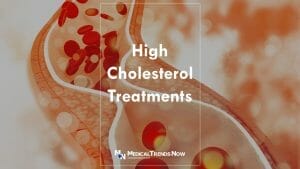Table of Contents
High cholesterol is a major concern in the Philippines, as it is a risk factor for developing cardiovascular diseases such as stroke and heart attack. Fortunately, there are treatments available to help lower high cholesterol levels and reduce the risk of these serious health issues. This article will examine the various treatments for high cholesterol in the Philippines, discussing their effectiveness and potential side effects. It will also provide an overview of lifestyle modifications that can help minimize or manage high cholesterol among Filipinos.
Learn about the effective treatments for high cholesterol in the Philippines, from dietary changes to medical interventions. Get informed and take control of your health today!
High Cholesterol: Overview
High cholesterol is a major risk factor for heart disease and stroke caused by a buildup of cholesterol in the arteries. Although lifestyle changes such as diet and exercise are recommended to reduce cholesterol levels, some people require medical treatment to achieve healthy levels. Statin medications are often prescribed to lower LDL cholesterol, while fibrates can be used to reduce triglyceride levels.

Foods That Commonly Cause High Cholesterol Levels
High cholesterol levels can be caused by various foods, including those high in saturated and trans fats. Common foods contributing to high cholesterol levels include red meat, processed meats, whole-fat dairy products, butter, lard, and fried foods. Additionally, many commercially prepared baked goods and snack foods such as chips and crackers contain high levels of trans fats. Reducing the consumption of these foods can help lower your cholesterol levels and improve your overall health.
Filipinos At Risk For High Cholesterol Levels
Filipinos at risk for high cholesterol levels are those with a family history of cholesterol problems, those with an unhealthy diet or lifestyle, and those with certain medical conditions. Those at risk should work to reduce their risk factors by eating a healthy diet, exercising regularly, and maintaining a healthy weight. If lifestyle changes are insufficient to lower cholesterol levels, medications may be used as a treatment option. It is important to note that high cholesterol levels can increase the risk of heart disease and stroke, so those at risk need to seek out proper treatment.
Complications Of High Cholesterol Levels
High cholesterol levels can cause several health complications, including an increased risk of heart disease, stroke, and type 2 diabetes. Filipinos with high cholesterol levels are also at greater risk for developing peripheral artery disease, affecting blood flow to the limbs.
High cholesterol levels can also lead to an accumulation of fatty deposits in the arteries, limiting the flow of oxygen-rich blood and causing narrowing or blockage of the arteries. If left untreated, this can lead to serious health problems such as heart attack or stroke. Therefore, it is important to recognize the signs and symptoms of high cholesterol and seek treatment as soon as possible.
Treatments For High Cholesterol in the Philippines
High cholesterol levels can be managed and treated with a combination of lifestyle changes and medications. Lifestyle changes may include eating a healthy, balanced diet, exercising regularly, and quitting smoking. Treatment options for high cholesterol include statins, bile acid sequestrants, cholesterol absorption inhibitors, and fibrates. Speaking with your doctor about the best treatment plan for you is important.
1. Medication Treatments For High Cholesterol
Medication is a key component of any treatment plan when it comes to treating high cholesterol. Popular medications include statins, which are used to reduce the amount of ‘bad’ cholesterol in the blood, and other drugs, such as fibrates and bile acid sequestrants, which also help reduce cholesterol levels. It is important to speak with a doctor or healthcare provider before starting any medication, as some medications may have side effects or interact with other medications.
The Statins
Statins are a class of drugs commonly used to treat high cholesterol. They work by blocking the production of cholesterol in the liver, ultimately reducing the amount of LDL (bad) cholesterol in the blood. Statins are generally well-tolerated and have been shown to reduce the risk of heart attacks and strokes in Filipinos with high cholesterol levels. However, some Filipinos experience side effects such as muscle pain, so discussing potential risks with your doctor before starting a statin regimen is important.

Bile acid sequestrants
Bile acid sequestrants are a type of cholesterol-lowering medication used to treat high cholesterol levels. These medications work by binding bile acids in the intestine, which helps to reduce cholesterol absorption in the gut. Common side effects include constipation, nausea, and abdominal pain.
Bile acid sequestrants are best taken with a meal and should be taken consistently to achieve the best results. Patients should speak with their healthcare provider to determine if bile acid sequestrants are the right treatment option for them.

Cholesterol absorption inhibitors
Cholesterol absorption inhibitors are an important class of medications used in the treatment of high cholesterol for Filipino patients. These drugs work to reduce the amount of cholesterol absorbed from food in the small intestine and thereby reduce overall cholesterol levels in the body.
Examples of cholesterol absorption inhibitors include ezetimibe and colesevelam, both of which are available as prescription medications. Clinical studies support the use of these drugs as a safe and effective means to lower cholesterol levels and reduce the risk of cardiovascular disease.
![ATORZETAtorvastatin (as calcium) + Ezetimibe 10 mg/10mg 1 Film Coated Tablet [PRESCRIPTION REQUIRED]](https://e52hyu4yuyt.exactdn.com/wp-content/uploads/2023/02/zoom-front-50031042-300x300.jpg?strip=all&lossy=1&ssl=1)
The Fibrates
Fibrates are one of the most commonly used medications for treating high cholesterol. They work by increasing the body’s production of LDL receptors, which help to reduce levels of low-density lipoproteins (LDL), commonly known as ‘bad’ cholesterol, in the bloodstream.
Fibrates also help reduce triglyceride levels, which are another type of fat found in the blood. In addition, fibrates can raise high-density lipoproteins (HDL) levels, commonly referred to as ‘good’ cholesterol. It is important to note that fibrates do not lower LDL cholesterol alone, but they can help when combined with other treatments, such as lifestyle changes and statins.

2. Diet
Diet is a key factor in reducing high cholesterol levels. Eating a well-balanced diet that is low in saturated fat, trans fat, and cholesterol and high in fiber can help to lower cholesterol levels. Additionally, it is important to limit the amount of sugar and processed carbohydrates consumed. Eating plenty of healthy food like fruits, vegetables, and whole grains can help ensure that dietary needs are met while reducing cholesterol levels.
Foods That Lower Cholesterol Levels
- Oats, barley, and other whole grains
- Legumes, such as beans and lentils
- Nuts, such as walnuts and almonds
- Fatty fish, such as salmon, mackerel, and herring
- Foods high in fiber, such as fruits, vegetables, and whole grains
- Plant-based oils, such as olive oil, canola oil, and sunflower oil
- Foods fortified with sterols and stanols, such as margarine, orange juice, and yogurt
- Soy products
- Plant proteins, such as lentils, beans, and nuts
- Egg whites

3. Lifestyle Changes
Making lifestyle changes, such as exercising and eating a balanced diet, is the first-line treatment for high cholesterol. Replacing unhealthy fats with healthy fats, such as replacing butter with olive oil, and eating more fruits and vegetables, can also help to lower cholesterol levels. Reducing stress levels, quitting smoking, and limiting alcohol consumption can also aid in reducing cholesterol levels.
Lifestyle changes are important for Filipinos who are at risk of developing heart disease due to high cholesterol and should be taken seriously to reduce the risk of developing any associated health complications.
4. Exercise
Exercise is a key component of managing high cholesterol. According to the American Heart Association, regular physical activity helps raise HDL (good) cholesterol while decreasing LDL (bad) cholesterol. Filipinos with high cholesterol should aim for at least 30 minutes of moderate-intensity exercise per day, five days a week. Moderate-intensity exercise includes brisk walking, jogging, swimming, or cycling. Filipinos can also break up their exercise into shorter periods of 10-15 minutes throughout the day if it is more convenient for their schedule. Exercise can also help reduce stress and maintain a healthy weight, both of which are important for reducing cholesterol levels.

5. Vitamins And Minerals
In addition to lifestyle changes and medications, vitamins and minerals may be beneficial in the treatment of high cholesterol in the Philippines. Vitamin B3, also known as niacin, has been shown to help raise HDL (good) cholesterol levels and lower LDL (bad) cholesterol levels.
Additionally, studies have indicated that taking vitamin C, vitamin E, and omega-3 fatty acids may also reduce bad cholesterol levels. It is important to speak to a healthcare professional before taking any vitamins or minerals as part of a high-cholesterol treatment plan.
6. Omega 3 Fatty Acids
Recent research has demonstrated that Omega fatty acids are a promising form of treatment for high cholesterol. Studies have shown that Omega fatty acids can reduce total cholesterol levels, as well as lower triglyceride levels, and even raise HDL (good) cholesterol. However, the exact mechanism of this process is still not fully understood. These findings suggest that Omega fatty acids may have a significant role in the treatment of high cholesterol, and further research is needed to explore their potential.
7. Green Tea Extracts
Green tea is becoming an increasingly popular natural remedy for high cholesterol levels. Research has shown that green tea extracts may help lower both total and LDL cholesterol levels. A study conducted in China found that participants who consumed green tea extract daily saw significant decreases in their cholesterol levels after 12 weeks. Green tea extracts are a great option for those looking for a natural remedy to lower their cholesterol levels.
Takeaway: Treatments For High Cholesterol In The Philippines
There are many ways to treat high cholesterol levels. These treatments vary from person to person, depending on their health conditions and the medications they are taking. It is important to speak to a healthcare professional about a treatment plan that is tailored specifically to your needs.
Sources: Treatments For High Cholesterol
- High cholesterol – Diagnosis and treatment – Mayo Clinic
- Medicines for high cholesterol – NHS
- Prevention and Treatment of High Cholesterol (Hyperlipidemia) – American Heart Association
- High Cholesterol: Prevention, Treatment and Research – Hopkins Medicine
- Cholesterol-Lowering Drugs: Benefits & Side Effects – Cleveland Clinic
- Which Medicines Lower ‘Bad’ (LDL) Cholesterol? – WebMD
- 6 Tips If You’re Starting Treatment for High Cholesterol – Healthline
Disclaimer
This website is intended to educate both members of the general public and those working in the medical field on the prevalence, causes, and methods for preventing, diagnosing and treating diseases that affect people throughout their lives. This website’s content is provided solely for informational reasons and is not meant to serve as a substitute for the advice of a qualified medical practitioner.













